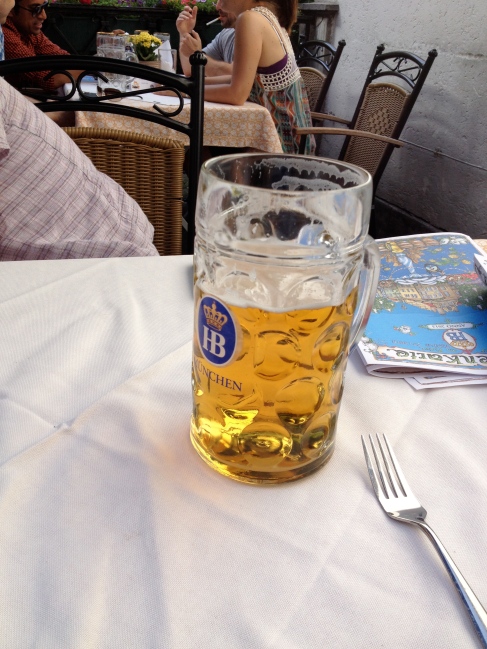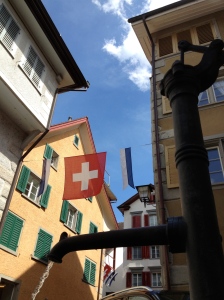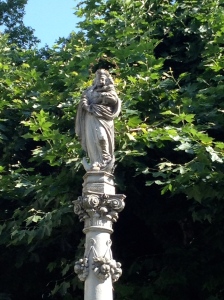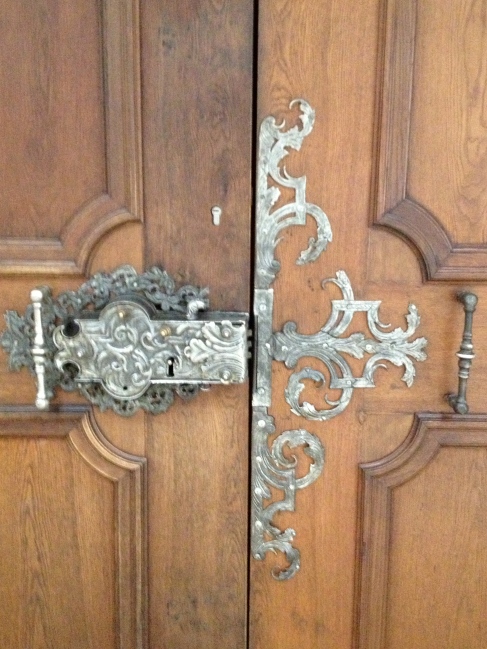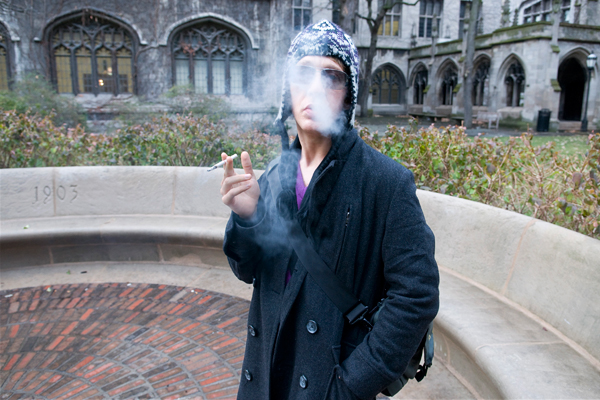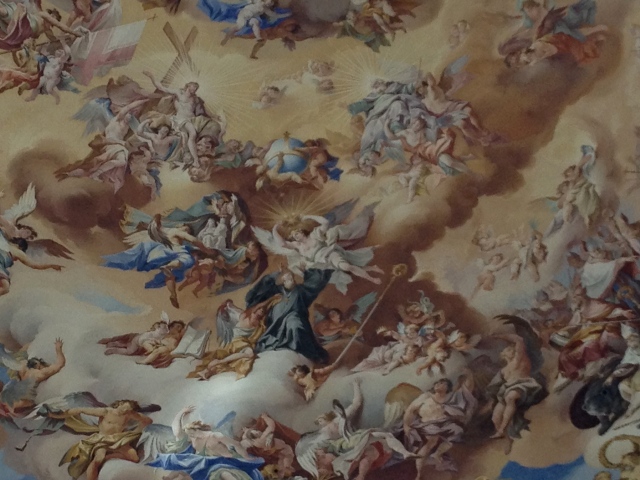Recently, I was blessed with the opportunity to travel abroad for some days, viewing parts of Switzerland, Liechtenstein, Austria and Bavaria. It is a corner of the world I had long wished to see, and my expectations were not disappointed. The landscape was beautiful, the people delightful (in a Germanic sort of way), the Churches stunning, the history rich, and the food, beer, wine and cheese all delicious.
However, what struck me in a particularly powerful way during this trip to Europe was the myriad of little examples of everyday beauty that dotted each city, town and village that we visited: the ways in which corners of buildings were marked with intricate wood carvings of saints and courtiers, or the sides of houses with devotional stucco paintings, window sills with stylistic curves, fence gates with wrought-iron flowers, even hay-fields with hand-made crucifixes.
Everything about Europe, of course, is fascinating to an American: whether it’s the fact that I drank tea out of 200 year-old porcelain, or found a McDonald’s in a 300 year-old town square. And, of course, we mustn’t assume that Europeans share this fascination or admiration for their own historical idiosyncrasies: most of the building corners built there since World War II, anyway, are as blandly utilitarian as anything in an American suburb.
But what struck me was just how foreign this former attention to little everyday beauty was to the American – and presumably also to the contemporary European – sensibility. Sure, we may find these displays of detail pleasant, quaint and charming, but when it comes down to understanding the mindset that gave rise to them we are quite at a loss. What’s the point? Why go through such effort and to such great lengths for sake of mere decoration? It doesn’t compute. It’s disproportionate. I mean, sure, nobody wants live surrounded by ugliness, but this doesn’t exactly require that I hire an artist to work on my front door.
All of this led me consider the question: what is the key difference between a culture that allows such a high value to be placed on everyday beauty, and our own wherein this value has apparently been so lost as to become practically unintelligible? What did they see that we no longer see; or perhaps, what do we see now that they did not? At one point on our journey I put this question to one of our hosts. His answer was somewhat paradoxical: the place of the transcendent.
Our forebears had room in their lives for such attention to beauty precisely because their vision of life afforded space to the transcendent dimension. The human being was not envisioned as ordered to an end within this life but rather as oriented to a fulfillment beyond it, and this very fact allowed for a certain degree of levity and leisure to be introduced into life. Precisely because it was not the locus of ultimate seriousness, it had room for the ‘waste’ of beauty in the little things. And this ‘waste’ was appropriate insofar as beauty naturally serves as a certain pointer to the higher, sacred dimension of reality, from which this world receives its significance. In this sense, even common little things can receive a note of dignity that takes them beyond themselves and their relatively unimportant everyday functions.
Conversely, in a culture lacking this transcendent dimension, wherein the ultimate significance of life is loaded entirely onto the immanent frame, there can be no place such superfluous displays. Here, everything must be ordered in utilitarian fashion to the end within life. There is no time to waste! Money must be made! Fun must be had! Success must be achieved! So long as things are basically functional and not utterly repulsive, they will suffice. There is no sense in spending extra time, energy and resources to embellish the eve-spout or the mail-box. If you must, go and buy some cheap kitsch at Wall-mart and move on. Anything else would be extravagant: a waste of time.
As the transcendent dimension recedes within a culture, so the place of beauty and the sensitivity to beauty recedes. In the not so distant past, a certain aesthetic sense governed even the construction of industrial factories. Now, however, utility is king. The place of beauty has been relegated to well-cordoned sectors of life – to churches and museums – and even there one must look to the past if one wishes to find genuine beauty. We seem incapable of producing any new examples in our modern institutes.
And so we Americans flock away on our European adventures, and Europeans build their bland condominiums around ancient medieval cores, and we enjoy the quaint charms of the past for a while, only to return back to our work-a-day world and continue on as cogs in the giant machine. There is some sense that we might be witness to a renewed romanticism in our day, evidenced in part by environmentalism and in part by the Hipster movement (though I would wish for less annoying versions to emerge). But here too we find only a vague sense of longing for something that is lost, without much sense of what that something is or how it is to be regained. We revolt, but remain basically dominated by that which we revolt against.
The great irony of all this is that the very movement that was supposed to invest this world with greater significance and import has in fact deadened the world and robbed it of its wealth of dignity. God and heaven were supposed to be the last impediments standing in the way of human progress; the illusions distracting us from the immanent utopia. But, in fact, we can see that, far from demoting the dignity of the world, they preserved and safeguarded it. Without the transcendent dimension, earth loses its charm.
This is the great claim of the Catholic tradition: that the highest dignity of a thing comes from its reference to God; that we do not promote the dignity of a thing by depriving it of this reference – changing it from an icon into an idol – but rather precisely by affirming it. This bestows on the object a value greater than it would otherwise have on its own. Thus the error of idolatry is not so much that it overvalues a created good, but rather that it undervalues it, depriving it of its glory by loading onto it a weight that it cannot support, such that it sinks into itself and becomes a distorted caricature of itself – like a hot-air balloon with a leaden top.
This is why the saint enjoys and values the world not less but more than the sinner, because he enjoys and values them in their reference to God as icons. He allows them to rise to the heights, precisely by not weighing them down with a false ultimacy.
This is why the Christian vision, that orients man to heaven, invests not less but more in the world, because it sees this world as an icon of the next, higher world, and this affords a heightened dignity. The world becomes all the more valuable and important when it is supposed to serve as a sign directing man to his transcendent destiny.
And this is the reason why a culture that has deeply interiorized this insight can afford to ‘waste time’ on beauty in the little things: because their significance is deeply intertwined with their insignificance. Such is the paradox of created existence…
… to quote an old saying:
Why do angels fly? Because they take themselves lightly.

